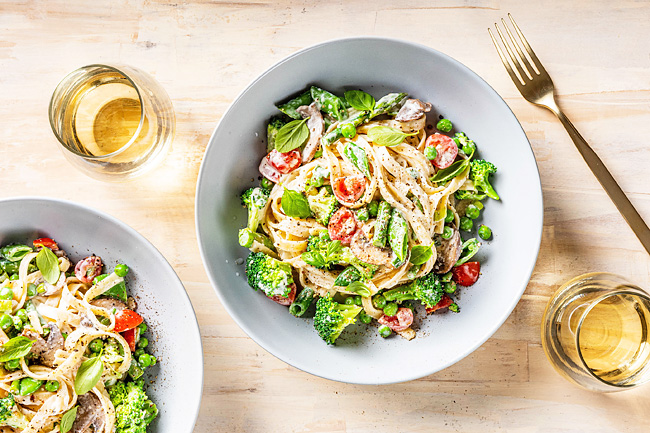G Daniela Galarza
THE WASHINGTON POST – It may have fallen out of vogue in the past few decades, but like bike shorts, bodysuits and other 1990s trends, it’s time to bring pasta primavera back.
The dish, which has many variations, combines pasta with gently cooked and fresh vegetables in a sauce rich with cream and sharp cheese. Because it’s a pasta dish named after the Italian word for springtime, I long assumed it was an old recipe from Florence or Emilia-Romagna.
In fact, it’s probably a North American invention, though its precise origins are disputed.
According to co-author of Sirio: The Story of My Life and Le Cirque Peter Elliot, the dish was first made by New York restaurateur Sirio Maccioni or his wife, Egidiana, in 1975 when they were vacationing at a Nova Scotia estate.
In The United States of Arugula, author David Kamp considers the possibility that it was invented by one of Le Cirque’s chefs, Jean Vergnes.
Amanda Hesser wrote in The Essential New York Times Cookbook that though he claimed it as his own, “Vergnes apparently hated the dish so much that he forced his cooks to prepare it in a hall outside the kitchen.”

Also often cited as its inventor is the artist Edward Giobbi, who loved to cook so much that he wrote a number of cookbooks beginning in the early 1970s.
The chef Jacques Pépin, who knew Giobbi back then, says Giobbi made it for Maccioni, who later put it on his restaurant’s menu.
Regardless of who made it first, by the time the recipe landed in the premiere issue of a magazine in 1978, it was well on its way to becoming an icon of the 1980s and 1990s.
Like so many trends, its popularity led to ubiquity. After every major publication and so many cookbooks published their own variations on the original, diners began to tire of the dish.
Critics noted that despite its Italian name, pasta primavera wasn’t found on restaurant menus in Italy.
In 2002, writing for The Post, Stephanie Witt Sedgwick reported that Italians might sometimes describe a recipe as alla primavera, but when they did, it was unlikely that they were referring to a pasta dish.
Hesser, writing for the New York Times in 2009, made the argument that, from an ingredient and technique standpoint, the dish was as French as it was Italian.
She called it “an absurdity of 1980s so-called seasonal cooking. Meant to be an expression of spring, the mad jumble of vegetables over pasta was mostly an expression of the death match between French and Italian cuisine (cream versus olive oil, sauce versus pasta)”.
It’s a fair point: The recipe Le Cirque’s founder cited as closest to the one that was served at the restaurant includes a number of summer vegetables – broccoli, zucchini, green beans and tomatoes – in addition to spring asparagus and peas. Enriching a sauce with cream and butter is more common in French cuisine than it is in Italian.
The recipe for pasta primavera that ran in the Times instructs the cook to blanch each green vegetable separately in salted water – a decidedly French level of fussiness.
Yet, in 2011, Barbara Damrosch unearthed a recipe in Italian culinary instructor and historian Giuliano Bugialli’s Bugialli on Pasta that could be seen as a precursor to modern pasta primavera.
His Pasta Alle Erbe, which he translates as Spaghetti With Spring Vegetables, is taken from a Renaissance Florentine cookbook and it features asparagus, scallions, peas, Swiss chard, and artichokes.
“In Florence, Swiss chard could easily winter over and come up in spring. Artichokes would do the same, their tasty buds edible until their purple flowers open in June. He adds lemon juice, pancetta, chicken broth and olive oil. No cheese.” And apparently no cream, either.
Its origin may be beside the point. When made well, with fresh ingredients and not too much fuss, pasta primavera is delicious.
Full of vegetables and coated with a barely there gloss of cream and parmesan sauce, this somewhat seasonal pasta dish is just as good today as it was when it was all the rage.
In my interpretation, mushrooms are sauteed in a skillet along with spring onions or scallions. A pinch of red pepper flakes adds a little spark. In a large pot, boil the pasta in salted water, and when it’s about halfway done, add the green vegetables: broccoli, snap peas, asparagus and frozen green peas.
These will be bright green and tender when the pasta is al dente. Reserve some of the pasta water and then drain everything into a colander.
Stir some cream and parmesan into the mushroom mixture, warming until the cheese melts, and then toss everything together with a couple of handfuls of cherry tomatoes. I like mine extra saucy, so I’d add another splash of cream.
Serve warm, topped with lots of cracked black pepper and fresh basil.
PASTA PRIMAVERA
Full of vegetables and coated with a barely-there gloss of cream and parmesan sauce, this somewhat seasonal pasta dish is just as good today as it was when it was all the rage in the 1980s.
Save time by cooking the green vegetables with the pasta. Not into broccoli or peas? Substitute other vegetables, such as artichoke hearts, chard or baby spinach.
The sauce can be made with heavy cream or half-and-half, but don’t skimp on the parmesan.
If you’re grating the cheese, use the small holes on a box grater rather than a Microplane for best results. If you’d rather use fresh spring peas, cook them for a full minute before draining.
INGREDIENTS
Two tablespoons olive oil
One cup sliced cremini mushrooms
Fine salt
Two spring onions or four scallions, thinly sliced
Pinch crushed red pepper flakes (optional)
One pound fettuccine
Half small head broccoli, cut into small florets
One cup chopped snap peas or snow peas
Four to six stalks asparagus, trimmed and cut into one-inch pieces
One cup frozen green peas
Two-third heavy cream or half-and-half, plus more as needed
Half cups grated parmesan cheese, plus more as needed
12 cherry tomatoes, halved (or quartered, if large)
Handful fresh basil leaves, torn, for serving
Freshly cracked black pepper, for serving
DIRECTIONS
Bring a large pot of salted water to a rolling boil.
Meanwhile, in a 10-inch skillet over medium-high heat, heat the olive oil until it shimmers.
Add the mushrooms and a pinch of salt and saute, stirring occasionally, until pale brown, about five minutes. Add the spring onions or scallions and cook, stirring occasionally, until warmed through, about one minute. Stir in the crushed red pepper flakes, if using, and remove the pan from the heat.
Add the fettuccine to the boiling water and cook approximately halfway, until malleable but still quite firm, four to five minutes. Add the broccoli, snap or snow peas, and asparagus.
Cook until the fettuccine is al dente – or done to your liking – and the vegetables are bright green and tender, four to six minutes. Stir in the frozen peas, and let them cook for 20 seconds. Reserve quarter cup of pasta water. Drain the pasta and vegetables, but do not shake them to dry further. Immediately transfer them back to the pot.
Return the skillet with the mushrooms and spring onions to medium heat. Stir in the cream or half-and-half, followed by the cheese, letting it melt. Add the mushroom and cream mixture to the pasta and vegetables, along with the cherry tomatoes and reserved pasta water, and cook, stirring, until the sauce just barely coats everything. Taste, and season with more salt, if desired. If you like the pasta saucier, add more cream and/or cheese.
Divide among four plates or shallow bowls, top with basil and black pepper, and serve.





